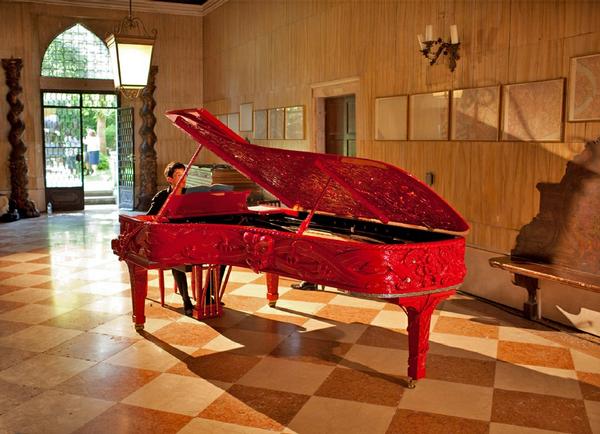Michael Parekowhai set to transform edge of red zone with art and music
Wednesday 27 June 2012, 5:50PM
546 views
From this weekend, traffic along Madras Street on the eastern edge of the city’s red zone will be unable to miss seeing two major sculptures by internationally-renowned New Zealand artist Michael Parekowhai.
Installed on a roadside empty site, they are part of a month-long presentation organised by Christchurch Art Gallery Te Puna o Waiwhetu.
Gallery director Jenny Harper, who was Commissioner for New Zealand at the 2011 Venice Biennale, says she is thrilled that this city has remained the chosen destination for the return of Michael Parekowhai’s extraordinary presentation at the 54th Venice Biennale.
“We are honoured that, despite the gallery’s closure, this major internationally-renowned Auckland artist who represented New Zealand so well in Venice has never faltered from showing his extraordinary installation here. The contrast between Venice and the edge of the red zone on Madras Street could not be more marked, but our and Parekowhai’s resolve to show it here has not faltered for over two years.”
The exhibition of On First Looking into Chapman’s Homer follows its presentation at the renowned Musée du quai Branly in Paris which gallery staff helped install after the Venice Biennale closed. It will be available to the people of Christchurch from 30 June to 29 July 2012.
The artist has reconfigured the installation especially for Christchurch. Here the spectacular carved Steinway piano, He Kōrero Pūrākau mo Te Awanui o Te Motu: Story of a New Zealand river will be upstairs in the Gallery’s offsite space above NG boutique and The National at 212 Madras Street. On the now vacant lot over the road two bronze grand pianos, each supporting a life-sized bronze bull, take their place against a drastically altered landscape.
While all the works in On first looking into Chapman’s Homer are sculptural, Parekowhai describes performance as central to his installation:
“The objects are the setting, but performance is central to this work. Much of its real meaning comes through music, which fills space like no object can.”
The piano will be regularly played throughout the its showing in Christchurch as it was in Venice. Four of the pianists who performed in Venice will play it again here during weekend opening hours with other slots filled by others, including music students from the University of Canterbury and CPIT.
Gallery director Jenny Harper says the carved piano was imported into New Zealand and played by Lilli Krauss in the 1950s. Michael Parekowhai’s transformation of this amazing instrument is intricate, surprising and personal.
“The artist has crafted a masterpiece which needs others – both players and the audience – to be completed.
“In a world where individuality often takes precedence, this work is made to be a collaboration. It took the co-operation of others to make, and it requires ours to complete.
The exhibition, which takes its name from a poem by English Romantic poet John Keats, represents a ‘classic turn’ by Parekowhai, she says.
“The work has been beautifully made using traditional materials and techniques, both European and Maori. So it stands out at a time when a lot of contemporary art is makeshift, site-specific and easily transported. It looks backward to the traditions of Europe and forward to this part of the world – a place Keats could not have imagined – with ease.
“Parekowhai is well-known for surprising and witty works that bring together a range of narratives and are delivered with a showman’s panache.”
Michael Parekowhai is associate professor at the University of Auckland’s Elam School of Fine Arts; he was made an Arts Foundation New Zealand Laureate in 2001. He has an extensive exhibition history and his work features in most public and many private collections in New Zealand and Australia, as well as further afield.
New Zealand’s presence at the Venice Biennale is supported by Creative New Zealand, the Venice Biennale patrons, and Te Papa. TelstraClear are supporting the exhibition in Christchurch by enabling visits of schools from low decile areas in the final two weeks.
